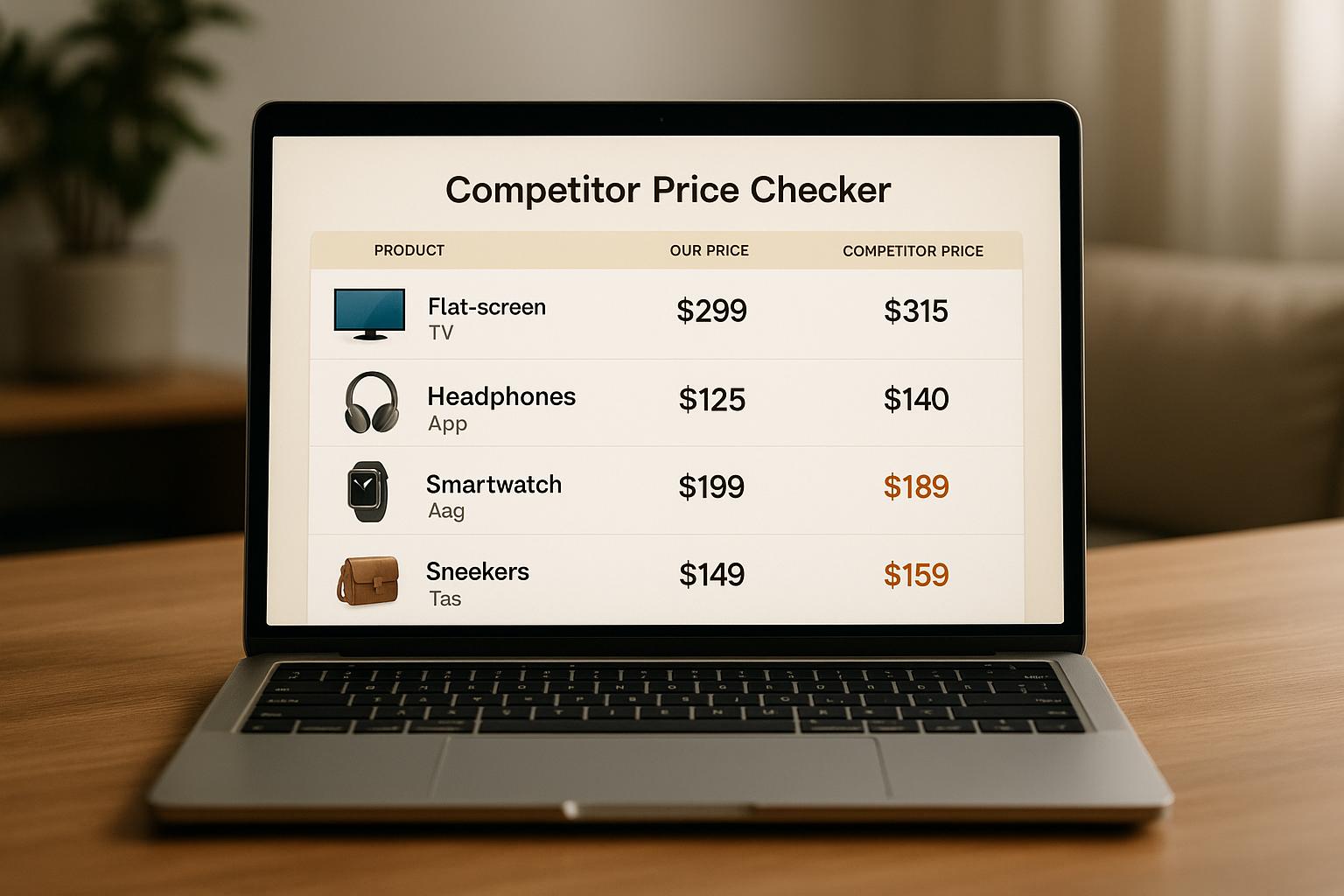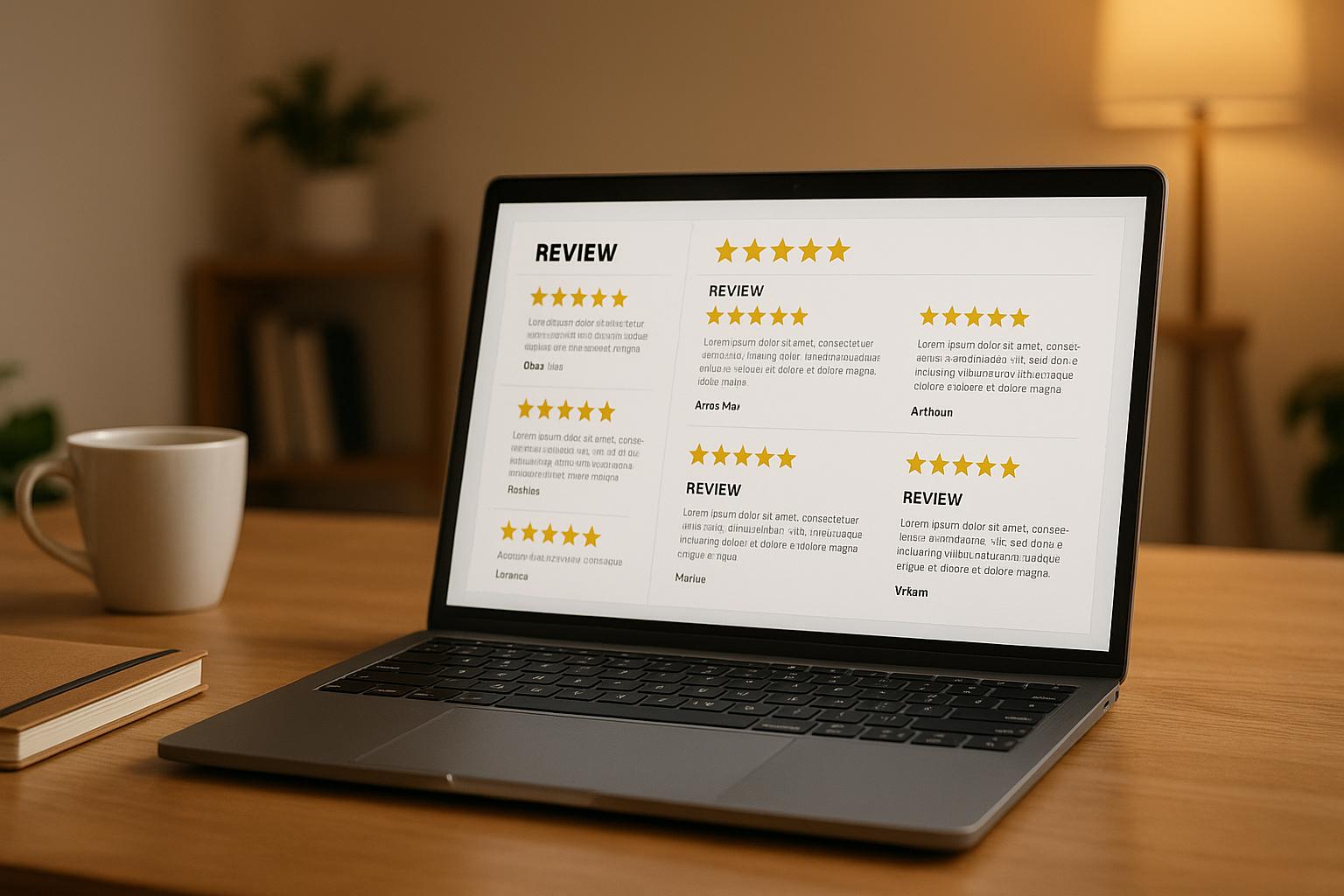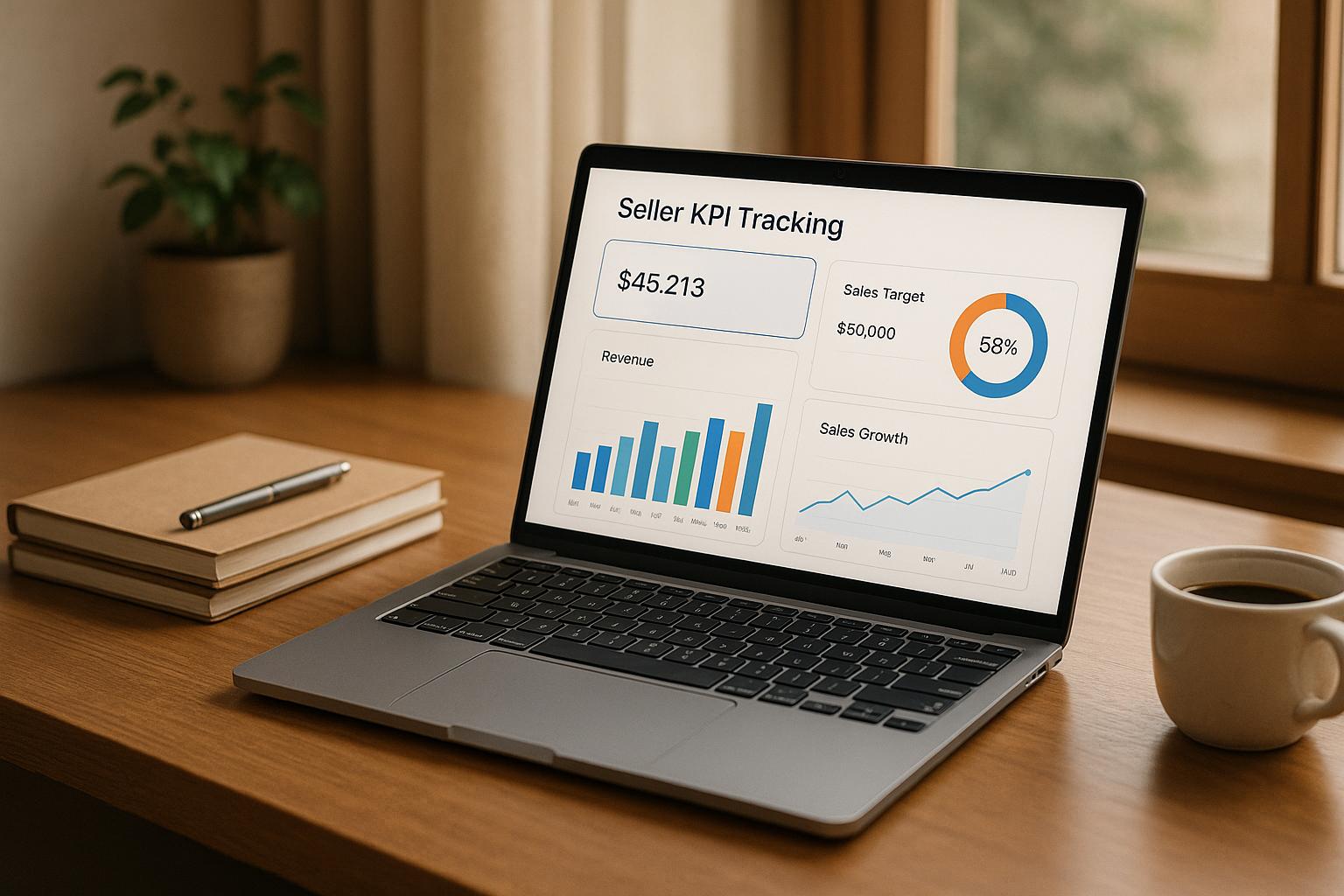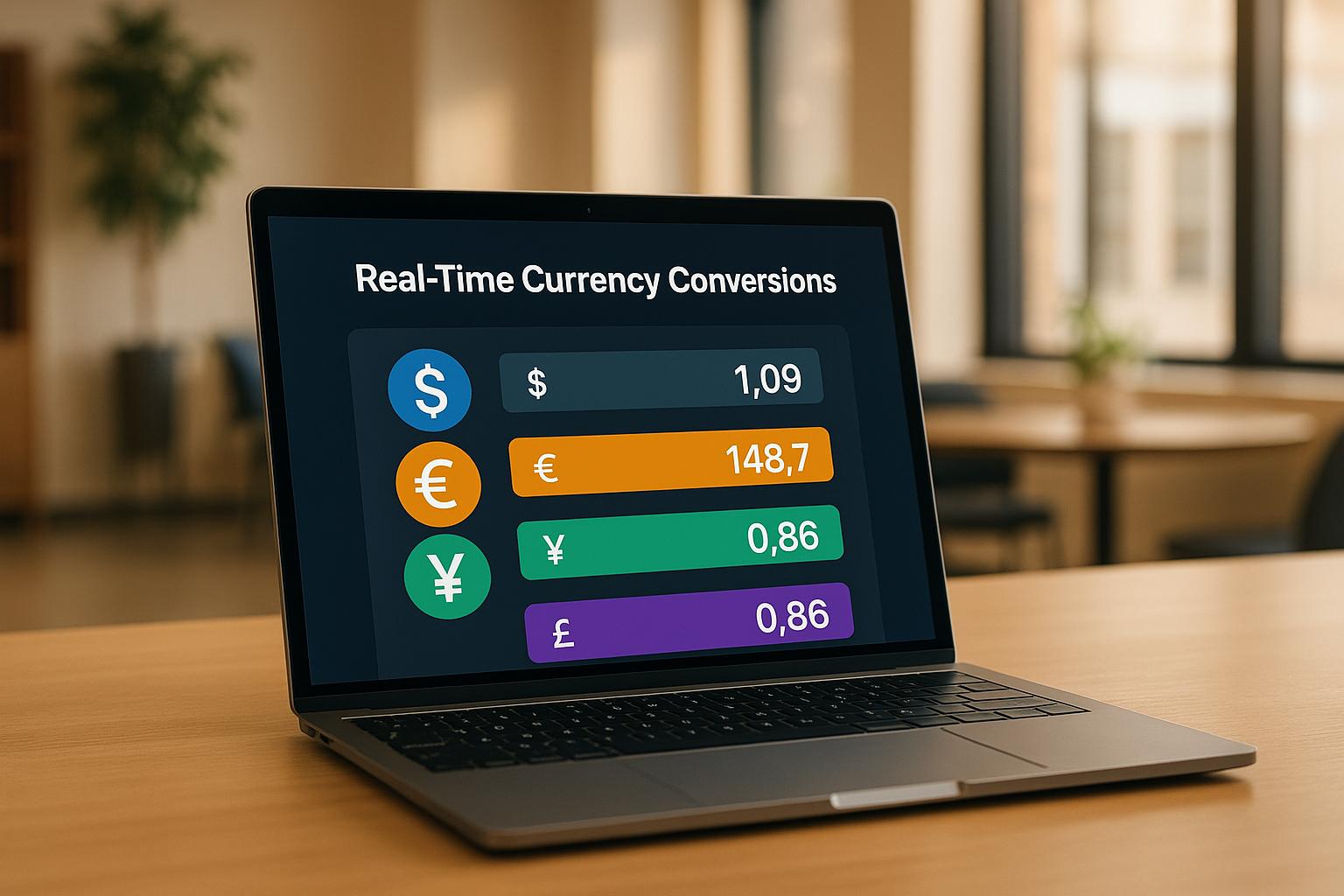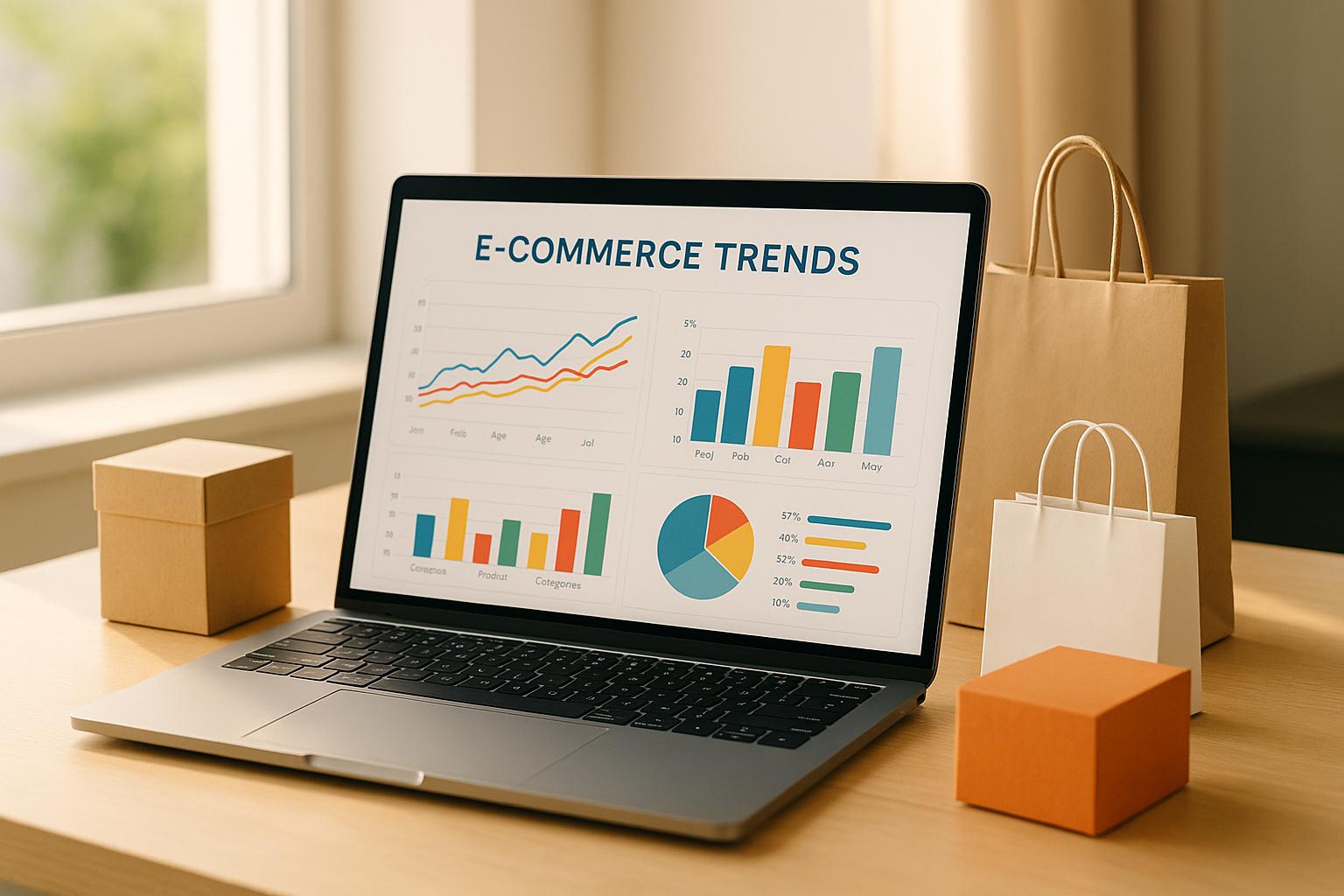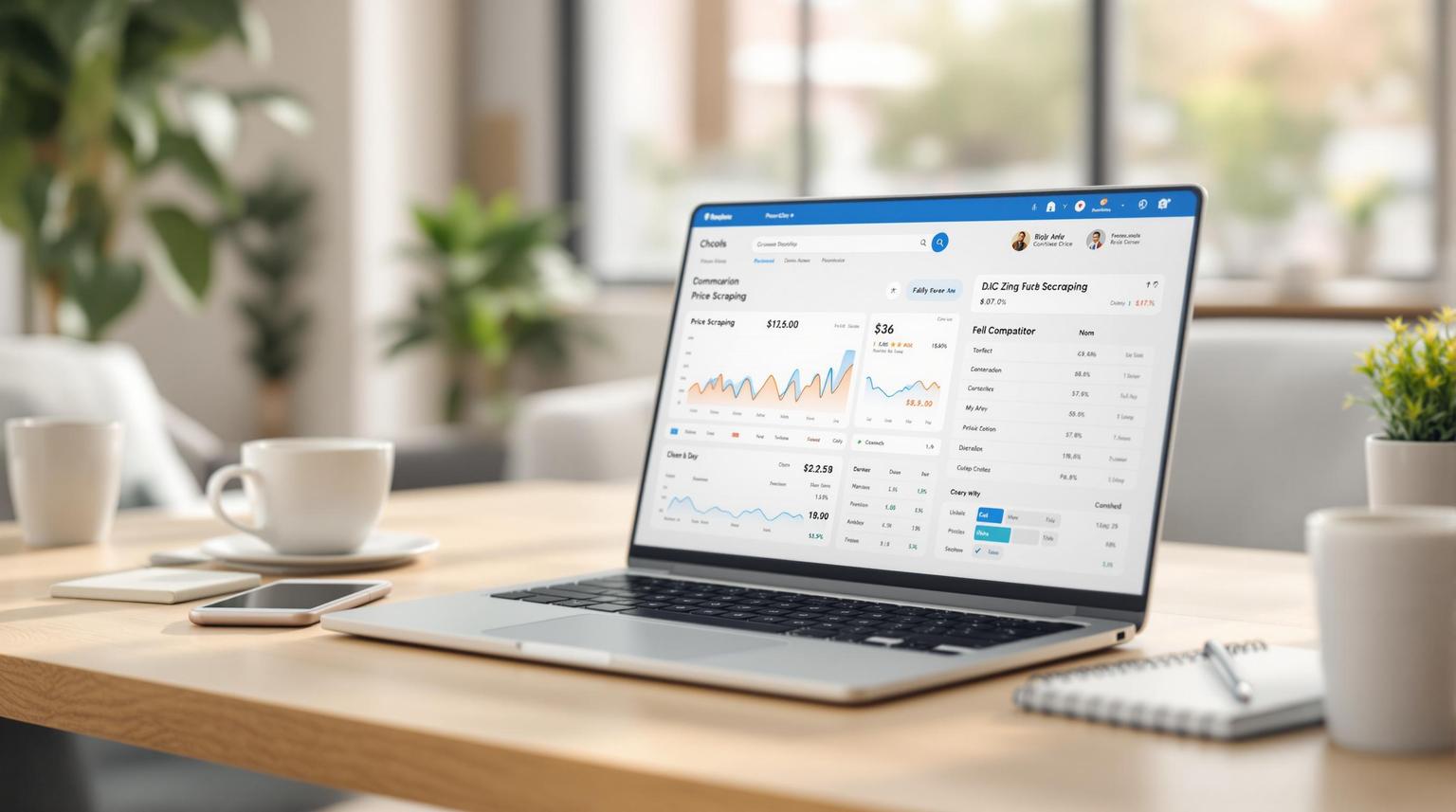Real-Time Pricing APIs: Cost-Saving Strategies
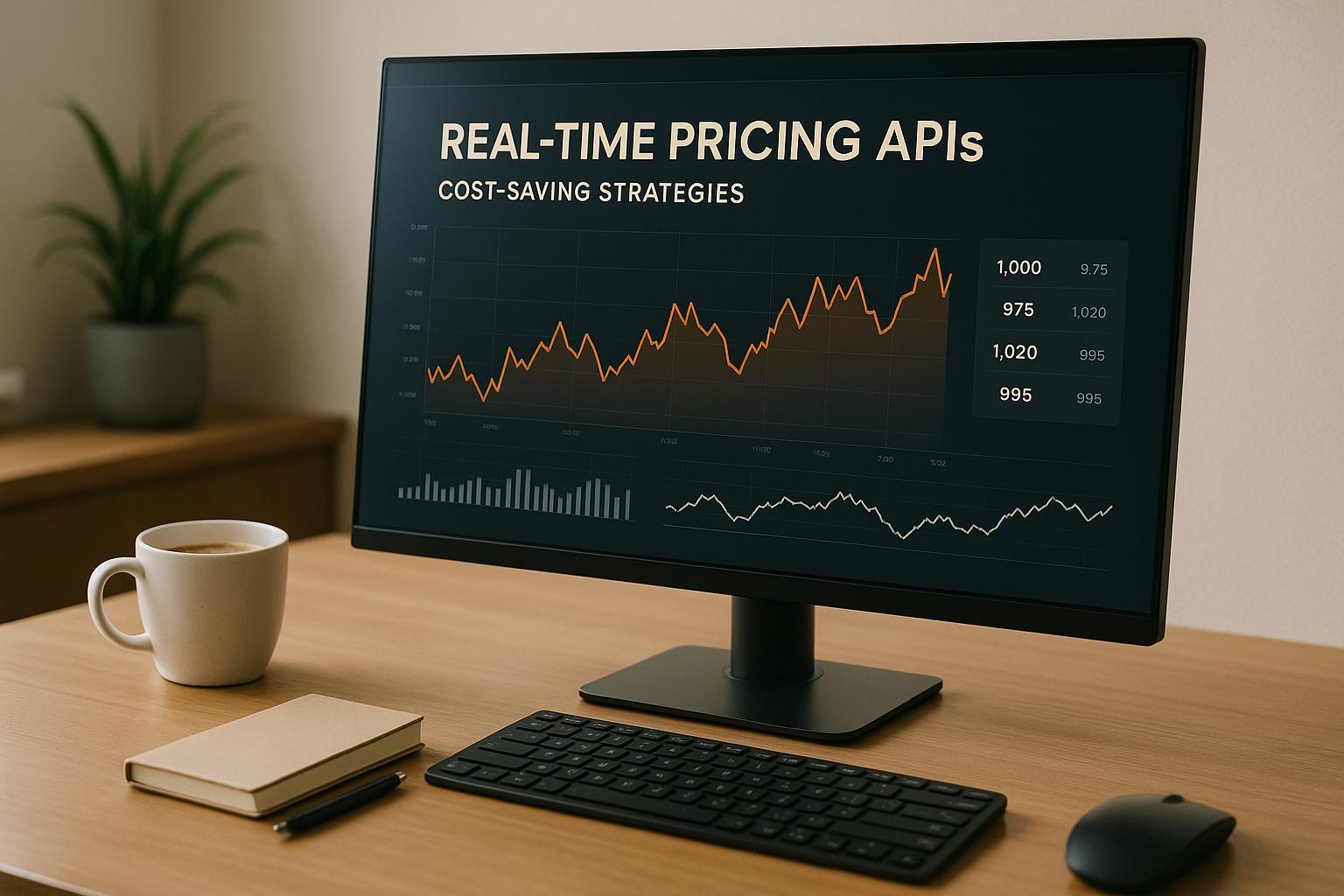
July 28, 2025
Real-time pricing APIs are transforming e-commerce by automating tasks like price tracking, competitor analysis, and inventory monitoring. They help businesses implement dynamic pricing strategies, improve profit margins by up to 20%, and drive revenue growth of up to 40% annually. Key benefits include seamless integration with tools like CRMs, advanced data filtering (e.g., EAN matching), and flexible pricing models.
API pricing models vary widely, from pay-as-you-go and subscription plans to enterprise licenses and freemium options. Costs are influenced by factors like request volume, data size, and advanced features. Businesses can save up to 70% on API expenses by optimizing usage through caching, batching requests, and using data compression.
ShoppingScraper, a popular platform, offers flexible plans starting at $1/month for individuals and scaling up to enterprise solutions. Its features include real-time monitoring, automated scheduling, and precise product matching, making it a cost-effective choice for businesses of all sizes.
Key Takeaways:
- APIs automate pricing and competitor tracking, boosting efficiency and profits.
- Pricing models include pay-as-you-go, subscription, tiered, and freemium.
- Cost-saving methods: caching, request batching, and data compression.
- Popular platform: ShoppingScraper ($1–$749+ per month) with flexible plans and high data accuracy.
For businesses, balancing performance with cost control is crucial when scaling API usage. Monitoring tools, scaling rules, and regular audits ensure efficient and affordable operations.
API Pricing Models and Cost Factors
Grasping how API providers structure their pricing is essential for managing expenses while scaling real-time pricing operations. The pricing model you choose can significantly influence your monthly costs. In 2023, surveys revealed that nearly two-thirds of companies had APIs contributing to their revenue, with 43% reporting that APIs accounted for over a quarter of their income. As APIs become more integral to business strategies, pricing structures have grown more intricate, requiring careful navigation. Below are the most common pricing models, each tailored to meet different operational needs.
Common API Pricing Models
Pay-as-you-go models charge based on the exact number of API requests made. This option is ideal for businesses with fluctuating usage or those just beginning to integrate real-time pricing data. Companies with seasonal or variable demand often benefit from this flexibility.
Subscription-based pricing involves a recurring monthly or annual fee, typically offering different tiers based on usage limits and features. This model appeals to many U.S. businesses because it simplifies budgeting. Higher-tier plans often include perks like faster response times, priority support, and advanced tools such as access to historical data or custom integrations.
Tiered pricing structures blend elements of pay-as-you-go and subscription models. They provide service levels at various price points, with each tier including a set number of API calls. Overages incur additional charges, making this model suitable for businesses looking to scale while maintaining cost predictability.
Enterprise licensing is designed for large-scale operations requiring extensive customization, dedicated support, and higher usage limits. Though these plans often involve significant upfront costs, they offer the most comprehensive access, making them a practical choice for companies handling millions of pricing requests each month.
The freemium model offers basic API access at no cost, with charges for advanced features, higher usage limits, or premium support. This approach allows businesses to evaluate the API's capabilities before committing to a paid plan. However, free tiers often come with restrictions, such as limited request volumes or reduced data freshness.
| Pricing Model | Pros | Cons |
|---|---|---|
| Pay-As-You-Go | Low entry barrier, scalable, predictable per-request costs | Unpredictable monthly expenses, risk of high bills during peak usage |
| Subscription-Based | Predictable costs, easy budgeting, reduced billing complexity | Less flexibility, potential overpayment for low usage |
| Tiered Pricing | Addresses diverse needs, encourages upgrades, clear value | Complex structure, risk of overwhelming choices |
| Enterprise Licensing | Customization, dedicated support, volume discounts | High upfront costs, less transparent pricing |
| Freemium | No-risk trial, smooth onboarding | Limited features, pressure to upgrade |
While pricing models set the framework, understanding the factors that drive costs is crucial for effective financial management.
Main Cost Factors in API Usage
Once you've chosen a pricing model, the next step is to manage the key cost drivers affecting your API usage. Request volume and data transfer size are two of the most significant factors. The more API calls you make and the larger the data payloads, the higher your costs. This is especially relevant for businesses monitoring thousands of products across multiple marketplaces, where frequent price checks can quickly add up.
Advanced features also come with higher price tags. APIs offering capabilities like real-time data feeds, advanced filtering, or specialized matching algorithms (e.g., EAN/GTIN matching or brand filtering) typically charge a premium. These features require more computational resources but provide added value for businesses needing precise, actionable data.
Request frequency is another critical factor. High-frequency requests can lead to extra fees for burst capacity or priority processing. For example, companies using dynamic pricing strategies that adjust rates multiple times per hour will incur higher costs compared to those updating prices daily or weekly.
"Free API is being abused right now by bot scammers & opinion manipulators. There's no verification process or cost, so easy to spin up 100k bots to do bad things. Just ~$100/month for API access with ID verification will clean things up greatly." - Elon Musk
Managing these costs effectively starts with analyzing your specific usage patterns and aligning them with the most suitable pricing model. With APIs driving more than 75% of total income for 21% of organizations, optimizing costs isn't just a technical concern - it’s a critical business strategy.
Cost-Saving Methods for Real-Time Pricing APIs
Once you’ve familiarized yourself with pricing models and cost factors, the next step is figuring out how to trim expenses without sacrificing the performance your business relies on. Some of these strategies can help you slash costs by more than 70%. Let’s dive into how you can turn your pricing API choices and usage into real savings.
Choosing the Right API and Usage Patterns
Picking the right type of API is crucial for keeping costs under control. For example, HTTP APIs typically cost about $1.00 per million requests, while REST APIs can run you $3.50 for the same volume. That means 216 million monthly requests could cost $216 with HTTP APIs but over $750 with REST APIs. WebSocket APIs, on the other hand, are priced at $1.00 per million messages, with an additional $0.25 per million connection minutes.
For simple pricing data retrieval, HTTP APIs are a cost-effective choice, offering basic request-response functionality. REST APIs, though more expensive, provide added benefits like stronger security, request validation, and advanced caching options - features that are often essential for enterprise-level applications.
You can also cut down on expenses by optimizing how you use APIs. Instead of making continuous calls, schedule updates on an hourly or daily basis to reduce the frequency of requests.
"Optimal pricing management finds the balance between functionality and cost." - Adrian Machado, Staff Engineer
Using Caching and Data Compression
Your choice of API is only part of the equation - how you handle the data can have a big impact on costs, too. Strategic caching can reduce processing expenses by as much as 30%. Using multiple layers of caching is a smart move. For instance:
- Client-side caching for data that rarely changes.
- API Gateway caching for routine queries.
- Backend caching for database results.
A practical example? A retailer could cache static product details like descriptions and images for 24 hours, while updating price data several times a day. This approach minimizes data transfer costs, especially when product details make up a significant chunk of the payload.
Data compression is another effective tool. Using gzip, you can shrink response sizes by 60–80%, cutting down on transfer costs and boosting API performance. Additionally, you can reduce data usage by optimizing API responses - return only essential fields like price, availability, and the last-updated timestamp. Edge caching, made possible through content delivery networks, stores API responses closer to end users, reducing latency and offloading requests from your primary API Gateway.
Request Batching, Rate Limits, and Volume Discounts
Consolidating multiple API calls into a single request - known as request batching - can significantly reduce overhead. For example, instead of making separate calls for each product’s pricing data, you can bundle multiple products into one request. Similarly, well-designed endpoints that fetch pricing, inventory, and competitor data in a single call can save both time and money. One financial services company that shifted from public to private API gateways saw a 40% reduction in data transfer costs, along with improved security and faster communication.
Rate limiting and quotas are another way to manage costs. By setting limits based on actual usage patterns, you can avoid unexpected spikes in expenses. This is especially important since many cloud resources are over-provisioned by 30–45%.
As your usage scales, volume discounts can offer additional savings. Keep detailed records of your current API consumption, seasonal trends, and growth projections to negotiate better rates. You can also take advantage of free tiers for development and testing before committing to full-scale production.
"Sometimes the best way to cut API Gateway costs is questioning whether you need AWS API Gateway at all." - Zuplo Blog
| Cost-Saving Method | Potential Savings | Implementation Complexity | Best For |
|---|---|---|---|
| HTTP vs REST API Selection | Up to 71% reduction | Low | Simple pricing applications |
| Strategic Caching | Up to 30% reduction | Medium | Frequently accessed data |
| Request Batching | Significant reduction | Medium | Large product catalogs |
| Data Compression | 60–80% payload reduction | Low | All applications |
| Private API Gateways | 40% data transfer savings | High | Enterprise applications |
The secret to effective cost management lies in layering these strategies. Start with the basics - select the right API type and implement simple caching. As your needs evolve, you can adopt more advanced techniques to maximize savings while meeting your performance requirements.
Monitoring and Managing API Costs
To keep your API expenses in check, monitoring and proactive management are just as important as implementing cost-saving strategies. With companies reportedly wasting up to 32% of their cloud budgets, staying on top of your API usage can make a real difference to your bottom line. The key is to track usage carefully and adjust scaling policies as needed.
Usage Tracking and Cost Alerts
Real-time monitoring provides critical insights into your API's performance and cost efficiency. By keeping an eye on factors like uptime, response time, and error rates, you can identify issues before they spiral out of control. Automated alerts are particularly helpful here. For instance, you can set up notifications to trigger when error rates exceed 5%, allowing you to act quickly and avoid unnecessary costs.
When choosing monitoring tools, pricing can vary widely based on the features and scale you need. Some tools offer free plans with limited capabilities, while others charge based on usage. For example, Better Stack has a free basic plan, with paid options starting at $25/month for freelancers. On the enterprise side, Datadog charges $5/month for API tests and $12/month for browser tests.
ShoppingScraper simplifies this process with built-in monitoring tools that track your monthly API request usage across all pricing tiers. Whether you're on the $1 Hobby plan with 100 requests or the Enterprise plan with over 500,000 requests, the platform gives you clear visibility into your consumption. You can even export data in JSON or CSV formats for deeper analysis. Additionally, its automated scheduling feature helps you avoid unnecessary API calls during off-peak hours, keeping costs under control.
"It's a lot easier to scale proactively than to play catch-up when your system is already overloaded." - Harman Singh, Senior Software Engineer, StudioLabs
Scaling Rules and Cost Audits
Beyond monitoring and alerts, defining scaling rules and conducting regular audits can further optimize your API spending.
Automated scaling ensures your resources match demand. For example, you can configure your system to increase API capacity during high-traffic seasons and scale back during quieter periods. The key is to align your scaling policies with business goals and usage patterns.
Regular audits are equally important for identifying inefficiencies and reducing waste. Keep detailed logs to support audits, troubleshoot issues, and ensure compliance. When auditing, evaluate both technical metrics, like response times and error rates, and business metrics, such as the value generated by each API call. For instance, a pricing API call that directly leads to a sale holds more value than one that simply updates cached data.
ShoppingScraper supports scaling with its flexible pricing tiers. The Growth plan, priced at $199/month, includes 50,000 requests, while the Advanced plan at $399/month offers 150,000 requests, with additional capacity available at $29 per 10,000 requests. This structure allows businesses to scale up as needed without overspending.
Integrating these strategies with DevOps processes can also enhance efficiency. Automated tests after each deployment ensure your API integrations remain reliable and cost-effective. By regularly analyzing the data collected, you can maintain optimal performance and keep expenses predictable.
"Scaling APIs isn't just about adding more servers; it's about designing systems that can grow while staying reliable and efficient." - Dileep Kumar Pandiya, Principal Engineer, ZoomInfo
Combining real-time monitoring, automated alerts, scaling rules, and regular audits creates a well-rounded cost management approach. This ensures your APIs remain functional and efficient while delivering consistent value as your business grows.
sbb-itb-65e392b
Case Study: Cost Reduction with ShoppingScraper

In the U.S., businesses are turning to ShoppingScraper to trim expenses and streamline operations. These case studies showcase measurable gains in pricing strategies, operational efficiency, and competitive positioning across various industries (source:).
How Businesses Use ShoppingScraper
Electronics retailers are among the many industries leveraging ShoppingScraper to cut monitoring costs and improve profit margins. For instance, a prominent electronics retailer reported a 45% reduction in price monitoring costs, a 28% boost in profit margins, and a 30% increase in its Google Shopping match rate. This success was achieved by automating pricing intelligence, which eliminated the need for manual competitor research.
Nedis, a leading distributor, integrated ShoppingScraper into its core operations. Arjan Pelle, Manager of Business Intelligence, shared how the platform has transformed their decision-making:
"ShoppingScraper has become an integral part of our distribution strategy. The product and pricing data it provides allows us to make smart decisions about our inventory and pricing."
Badkamerwinkel.nl, an online retailer, improved its product data management by using ShoppingScraper's EAN-based matching system. Commercial Director Jos Roodhuizen noted:
"Matching products in ShoppingScraper is really easy. We just had to import our list of products with EAN codes and the system automatically scraped the right product information."
A pricing SaaS platform saw a 300% increase in market coverage, a 45% improvement in data accuracy, and a 28% growth in its customer base after adopting ShoppingScraper. Similarly, Sembot utilized ShoppingScraper's real-time pricing capabilities to sharpen its competitive edge. CEO Bartosz Ferenc explained:
"In a competitive market, you need every advantage you can get. ShoppingScraper gave us that edge, helping us outperform our competitors using real-time pricing data."
Another business experienced a 32% increase in buy box ownership, a 25% drop in unauthorized seller issues, and a 40% improvement in price compliance, resulting in higher revenue and reduced compliance costs.
Signify, a major player in e-commerce, incorporates ShoppingScraper into its daily operations. Remco Schevenhels, E-commerce Manager D2C, uses the platform to refine strategies and quickly adapt to market changes and competitor movements.
These success stories highlight how ShoppingScraper delivers value across diverse industries, setting the stage for a closer look at its pricing options.
ShoppingScraper Pricing Plans Comparison
ShoppingScraper offers pricing plans tailored to businesses of all sizes. Its usage-based model ensures companies only pay for the data they need, making it a flexible option for businesses with fluctuating seasonal demands.
| Plan | Monthly Price | Requests Included | Team Size | Marketplaces | Additional Requests | Best For |
|---|---|---|---|---|---|---|
| Hobby | $1 | 100 | 1 | Limited | Not available | Individual sellers testing the platform |
| Growth | $199 | 50,000 | 1 | 2 | Not available | Small businesses with regular monitoring |
| Advanced | $399 | 150,000 | 2 | 3 | $29 per 10,000 | Growing companies requiring team access |
| Enterprise | $749+ | 500,000+ | 5 | 5 | $15 per 10,000 | Large retailers with extensive catalogs |
The Growth plan at $199 per month is ideal for small to medium businesses, offering 50,000 monthly requests to monitor hundreds of products across two marketplaces. For companies needing more scalability, the Advanced plan provides 150,000 requests for $399 per month, with multi-user access and extra capacity available at $29 per 10,000 requests. Meanwhile, Enterprise customers enjoy the most cost-efficient pricing, with additional requests costing $15 per 10,000, making it suitable for large-scale operations.
ShoppingScraper has earned a 4.6/5 rating for value for money. Franklin K., Marketing Director at a consumer electronics company, shared:
"Instead of charging thousands for limited functionality, ShoppingScraper has all the features you need at a low price."
Pieter J., a Marketplace Operations Manager, highlighted its operational advantages:
"Ease of use because each result is formatted in the same way regardless of channel * Pay-per-use instead of pay-per-product * Better data-quality than competitors."
The pay-per-use model eliminates waste typical of traditional subscriptions, making it especially useful for businesses with seasonal spikes or those testing new markets. Additionally, with API response times under 4 seconds, ShoppingScraper supports real-time pricing decisions, enabling high-frequency trading and time-sensitive promotions with ease.
Summary: Real-Time Pricing APIs and Cost Control
Real-time pricing APIs play a crucial role in helping U.S. businesses stay competitive. With structured pricing strategies, companies can see revenue growth of up to 40% year-over-year. In fact, one out of every five e-commerce businesses now uses dynamic pricing to keep up with the fast-paced online marketplace.
To make the most of these tools, businesses need to strike a balance between performance and cost management. Leveraging real-time data can lead to better customer acquisition, stronger retention, and increased profitability. However, achieving these outcomes requires careful planning and smart cost control.
Techniques like caching, request batching, and data compression are practical ways to cut processing costs while ensuring data quality remains intact. Additionally, many businesses are turning to hybrid pricing models, which combine predictable costs with the flexibility to scale as needed.
Regular usage tracking and audits are vital for keeping costs in check while expanding operations.
Platforms like ShoppingScraper illustrate how integrating APIs can be both cost-effective and high-performing. With its simple pay-per-use pricing model and seamless API integration, businesses can efficiently manage expenses while accessing real-time e-commerce data. This approach has earned ShoppingScraper a solid 4.4/5 rating on G2.
FAQs
What’s the best way for businesses to choose a cost-effective API pricing model?
To pick an API pricing model that fits your budget, start by examining your usage patterns and specific project needs. The most common models include:
- Metered (pay-as-you-go): You pay based on how much you use the API.
- Subscription-based: A fixed recurring fee, often monthly or annually.
- Tiered: Pricing varies depending on usage levels, with different thresholds offering different rates.
Each option works best for different scenarios, so understanding your expected usage and budget is key.
Running short-term tests or simulations can help identify the model that matches your operational needs and customer expectations. By evaluating both current demands and future growth, you can choose a model that keeps costs manageable while maintaining performance.
How can I reduce API costs while maintaining high performance?
To keep API costs under control without compromising performance, consider these practical approaches:
- Streamline call frequency: Cut down on unnecessary API requests by grouping data requirements and eliminating redundant calls.
- Utilize caching: Temporarily store frequently accessed data to avoid repeated requests and improve response times.
- Opt for efficient data formats: Use lightweight formats like JSON and ensure only the necessary fields are transmitted, reducing data transfer overhead.
- Choose the right pricing model: Select tiered or usage-based pricing plans that fit your business needs, helping you avoid overspending.
These steps can help you manage expenses effectively while maintaining scalable and dependable APIs for your operations.
How does ShoppingScraper deliver accurate data and cost-effective solutions for businesses of all sizes?
ShoppingScraper delivers highly accurate data by leveraging AI-powered scraping tools, achieving an impressive pricing precision rate of up to 95%. This technology reduces errors significantly, giving businesses dependable, real-time insights into the e-commerce landscape.
For businesses aiming to save on costs, ShoppingScraper provides automated data extraction tools designed to fit the needs of both small startups and large enterprises. By cutting down on manual work and simplifying processes, it helps reduce operational expenses while offering scalable solutions that grow alongside your business.
Related Blog Posts












